
The ancient theatre of Taormina (Italian : Teatro antico di Taormina) is an ancient Greek theatre in Taormina, Sicily, built in the third century BC.

The ancient theatre of Taormina (Italian : Teatro antico di Taormina) is an ancient Greek theatre in Taormina, Sicily, built in the third century BC.
A Hellenistic theatre stood at Taormina from around the third century BC. The remains of another Hellenistic building have been found under the Roman cavea. Under Roman rule, the theatre was rebuilt, probably around the time of Hadrian or Trajan. It was remodelled in the third century AD, with the orchestra turned into an arena and the stage removed. [1]
The ancient theatre had a diameter of 107 metres (351 ft) and could hold around 10,000 spectators. It is one of the oldest theatres in Magna Graeca to have curved cavea, rather than the older trapezoidal design. The cavea were divided into nine sections. On either side of the skene was a basilica. [2] Today, the theatre is used as a venue for the annual arts festival Taormina Arte. [3]
The ancient theater of Taormina is featured extensively in the 1995 film, Mighty Aphrodite , starring Woody Allen, Mira Sorvino, Helena Bonham Carter, and F. Murray Abraham [4] . Abraham in particular is shown repeatedly onstage as the leader of a Greek chorus. The same Taormina theater is featured (28 years later) in season 2, episode 2 of the HBO series, The White Lotus (2023). In The White Lotus, Bert (played by a much older F. Murray Abraham) visits Taormina’s Greek theater while on a vacation to Sicily with his son (played by Michael Imperioli) and grandson.
Locri is a town and comune (municipality) in the province of Reggio Calabria, Calabria, southern Italy. Its name derives from that of the ancient Greek region of Locris. Today it is an important administrative and cultural centre on the Ionian Coast and within its province.
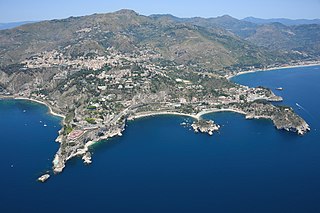
Taormina is a comune (municipality) in the Metropolitan City of Messina, on the east coast of the island of Sicily, Italy. Taormina has been a tourist destination since the 19th century. Its beaches on the Ionian sea, including that of Isola Bella, are accessible via an aerial tramway built in 1992, and via highways from Messina in the north and Catania in the south. On 26–27 May 2017 Taormina hosted the 43rd G7 summit.
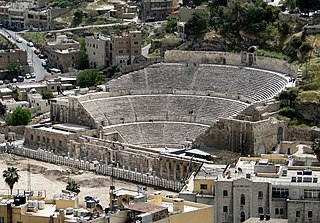
Roman theatres derive from and are part of the overall evolution of earlier Greek theatres. Much of the architectural influence on the Romans came from the Greeks, and theatre structural design was no different from other buildings. However, Roman theatres have specific differences, such as generally being built upon their own foundations instead of earthen works or a hillside and being completely enclosed on all sides.

Mighty Aphrodite is a 1995 American comedy film written, directed by, and co-starring Woody Allen, alongside Mira Sorvino, Helena Bonham Carter, Michael Rapaport, and F. Murray Abraham. The screenplay was vaguely inspired by the story of Pygmalion and is about Lenny Weinrib's (Allen) search for his genius adopted son's biological mother, ultimately finding that she is a dim-witted prostitute named Linda Ash (Sorvino).
The music of Sicily is created by peoples from the isle of Sicily. It was shaped by the island's history, from the island's great presence as part of Magna Grecia 2,500 years ago, through various historical incarnations as a part of the Roman Empire, then as an independent state as the Emirate of Sicily then as an integral part of the Kingdom of Sicily and later the Kingdom of the Two Sicilies, and, finally, as an autonomous region of the modern nation state of Italy.

The Theatre (UK) or Theater (US) of Pompey, also known by other names, was a structure in Ancient Rome built during the latter part of the Roman Republican era by Pompey the Great. Completed in 55 BC, it was the first permanent theatre to be built in Rome. Its ruins are located at Largo di Torre Argentina.

The Teatro Massimo Vittorio Emanuele is an opera house and opera company located on the Piazza Verdi in Palermo, Sicily. It was dedicated to King Victor Emanuel II. It is the biggest in Italy, and one of the largest of Europe, renowned for its perfect acoustics.

The Theatre of Marcellus is an ancient open-air theatre in Rome, Italy, built in the closing years of the Roman Republic. At the theatre, locals and visitors alike were able to watch performances of drama and song. Today its ancient edifice in the rione of Sant'Angelo, Rome, once again provides one of the city's many popular spectacles or tourist sites.

Hierapolis was originally a Phrygian cult centre of the Anatolian mother goddess of Cybele and later a Greek city. Its location was centred upon the remarkable and copious hot springs in classical Phrygia in southwestern Anatolia. Its extensive remains are adjacent to modern Pamukkale in Turkey.

Chiaramonte Gulfi is a town and comune in the province of Ragusa, Sicily, southern Italy.

The Nastro d'Argento, is an Italian film award, held since 1946 by the Sindacato Nazionale Giornalisti Cinematografici Italiani. Awards are given annually in a wide range of categories, covering not only feature films, but also short films and television series. The main awards are given at Taormina Film Fest, Sicily, while the short film awards ceremony is held in Naples.

Prusias ad Hypium was a city in ancient Bithynia, and afterwards in the late Roman province of Honorias. In the 4th century it became a bishopric that was a suffragan of Claudiopolis in Honoriade. Before its conquest by King Prusias I of Bithynia, it was named Cierus or Kieros and belonged to the Heraclea Pontica. Photius writes that it was called Kieros, after the river which flows by it.

Akrai was a Greek colony of Magna Graecia founded in Sicily by the Syracusans in 663 BC. It was located near the modern Palazzolo Acreide.

Taormina Film Fest (TFF) is an annual Italian film festival that takes place at Taormina, Sicily, Italy in July. It was established in 1955 in Messina, and in 1957 became Rassegna Cinematografica Internazionale di Messina e Taormina, until it moved permanently to Taormina in 1971. It had a succession of names before adopting its current name.

The Greek theatre of Syracuse lies on the south slopes of the Temenite hill, overlooking the modern city of Syracuse in southeastern Sicily, Italy. It was first built in the 5th century BC, rebuilt in the 3rd century BC and renovated again in the Roman period. Today, it is a part of the Unesco World Heritage Site of "Syracuse and the Rocky Necropolis of Pantalica".
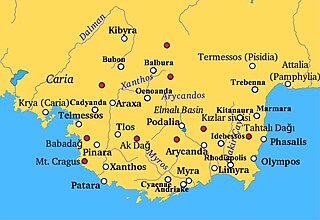
Balbura or Balboura was a town of ancient Lycia, the site of which is at Çölkayiği. The acropolis hill is about 90 metres above the plain of Katara.
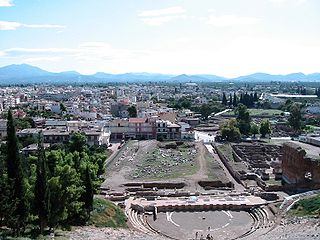
The Argos Theater was built in 320 BC. and is located in Argos, Greece against Larissa Hill. Nearby from this site is Agora, Roman Odeon, and the Baths of Argos. The theater is one of the largest architectural developments in Greece and was renovated in ca 120 AD.
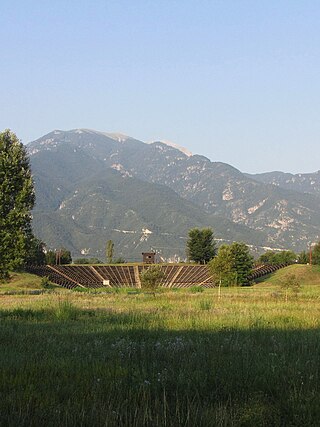
The largest building of the Archaeological Park of Dion in northern Greece is the Hellenistic-era theatre. It is located in the south of the village of Dion, Pieria and is often used during the summer for performances of the Olympus Festival.

The Roman Theatre of Catania consists of the ruins of two open-air semicircular ancient Roman theatres, located between Piazza San Francesco, via Vittorio Emanuele, via Timeo, and via Teatro Greco in the center of Catania, Sicily, southern Italy. The site consists of a larger theatre and a smaller semicircular theatre, an Odeon. The structure is part of the Parco archeologico greco-romano di Catania.

The Roman theatre of Volterra was discovered in the 1950s, during archaeological excavations of the ancient Roman city conducted by Enrico Fiumi. It is one of the best-preserved Roman theatres in Italy. It is located just outside the Porta Fiorentina, in an area called Vallebuona.